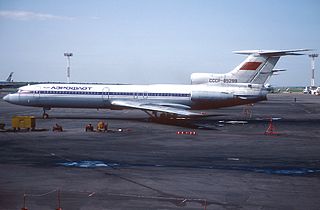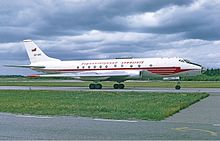
The Tupolev Tu-134 is a twin-engined, narrow-body jet airliner built in the Soviet Union for short and medium-haul routes from 1966 to 1989. The original version featured a glazed-nose design and, like certain other Russian airliners, it can operate from unpaved airfields.

The Tupolev Tu-104 is a retired medium-range, narrow-body, twin turbojet-powered Soviet airliner. It was the second to enter regular service, behind the British de Havilland Comet and was the only jetliner operating in the world from 1956 to 1958, when the British jetliner was grounded due to safety concerns.
This is a list of aviation-related events from 1973.
This is a list of aviation-related events from 1975.
This is a list of aviation-related events from 1976.

Aeroflot Flight 366, also known as the Miracle on the Neva, was a water landing by a Tupolev Tu-124 of the Soviet state airline Aeroflot. The aircraft took off from Tallinn-Ülemiste Airport (TLL) at 08:55 on 21 August 1963 with 45 passengers and 7 crew on board. The aircraft was built in 1962 and was scheduled to fly to Moscow–Vnukovo (VKO) under the command of 27-year-old captain Victor Mostovoy. After takeoff the nose gear did not retract. Ground control diverted the flight to Leningrad (LED) – because of fog at Tallinn.

The 1985 Zolochiv mid-air collision occurred on 3 May 1985 between Aeroflot Flight 8381 (Tu-134) and Soviet Air Force Flight 101 (An-26).

Aeroflot Flight 5143 was a domestic scheduled Karshi–Ufa–Leningrad passenger flight that crashed near Uchkuduk, Uzbek SSR, Soviet Union, on 10 July 1985. The crash killed all 200 occupants on board. Investigators determined that crew fatigue was a factor in the accident.
Aviaarktika was a Soviet airline which started operations on 1 September 1930 and was absorbed by Aeroflot on 3 January 1960.

Aeroflot Flight 4225 was a Tupolev Tu-154B-2 on a scheduled domestic passenger flight from Alma-Ata Airport to Simferopol Airport on 8 July 1980. The aircraft had reached an altitude of no more than 500 feet when the airspeed suddenly dropped because of thermal currents it encountered during the climb out. This caused the airplane to stall less than 5 kilometres from the airport, crash and catch fire, killing all 156 passengers and 10 crew on board. To date, it remains the deadliest aviation accident in Kazakhstan.

Aeroflot Flight 964 was a flight operated by Aeroflot from Kutaisi Airport, Georgia to Domodedovo Airport, Moscow, Russian SFSR. On 13 October 1973, the Tupolev Tu-104 operating on the route crashed during its approach to Moscow, killing all 122 passengers and crew on board. It remains the deadliest accident involving a Tupolev Tu-104.

Aeroflot Flight 3932 was a flight operated by Aeroflot from Koltsovo Airport to Omsk Tsentralny Airport. On 30 September 1973, the Tupolev Tu-104 operating the route crashed shortly after takeoff from Sverdlovsk, killing all 108 passengers and crew on board.

Aeroflot Flight 2003 was operated on 3 January 1976 by a Tupolev Tu-124, registration СССР-45037, when it crashed 7 km after take-off from Moscow–Vnukovo Airport (VKO/UUWW), on a domestic flight to Minsk-1 International Airport (MHP/UMMM), and Brest Airport (BQT/UMBB), Belarus. The crash killed all sixty-one on board and one in a house on the ground.

Aeroflot Flight 2415 was a regularly scheduled passenger flight from Moscow to Leningrad that crashed shortly after takeoff on 28 November 1976. The cause of the accident was attributed to crew disorientation as a result of artificial horizon failure in low visibility conditions.

Aeroflot Flight 513 was a domestic scheduled passenger flight operated by Aeroflot that crashed during takeoff from Kuybyshev Airport in the Soviet Union on 8 March 1965, resulting in the deaths of 30 passengers and crew. It was the first fatal accident involving a Tupolev Tu-124.

Aeroflot Flight 5484 was a scheduled domestic passenger flight from Odesa to Kazan with a stopover in Kyiv that experienced loss of control followed by breaking up in the air on 29 August 1979 over the Tambov Oblast, killing all 63 people on board. It remains the deadliest Tu-124 crash and regular passenger services with the Tu-124 were permanently suspended after the accident, but the Tu-124 was still used by the Soviet military after the accident.

Aeroflot Flight 2022 was a scheduled Soviet domestic passenger flight between Vilnius Airport in Lithuanian SSR and Vnukovo International Airport in Moscow, Russian SFSR, Soviet Union that crashed on 16 December 1973, killing all 51 people on board. The five hundred mile flight suffered a loss of control as a result of a malfunction of its elevator, causing it to crash as it made its final descent into Moscow. At the time of the crash it was the worst accident in aviation history involving a Tupolev Tu-124, since it entered service with Aeroflot in 1962.














